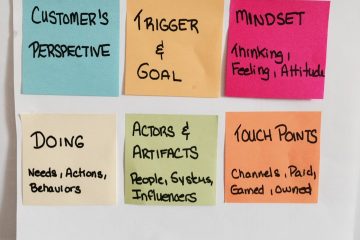Originally published by Justinmind, this UX and Prototyping Guru Q&A with me was also written by me. (Smart model btw!)
Identifying user needs should be the driving force behind business goals in digital marketing. As a UX digital marketing champion Jennifer Leigh Brown understands this:
“We have to be artists, researchers, data analysts, cognitive scientists, and strategists – but always advocates for the user.”
Jennifer is the Executive Planning Director of User Experience and Digital at Business-to-Business (B2B) marketing agency, Godfrey. As a UX marketing and digital strategist, she leads research-based strategies to deliver engaging digital customer experience and heads the team behind the B2B customer journey.
Her work revolves around user-centered principles, which ensure that her customers are at the heart of the marketing communications strategy at Godfrey.
In our Q&A, Justinmind talks to Jennifer about being a user advocate in the field of marketing, user research insights at Godfrey and crafting a valuable conversation with chatboxes.
Hi Jennifer! You’ve worked in UX testing, user experience, digital strategy and B2B and UX marketing – to name but a few of your areas of expertise. How would you describe the evolution of human factors research and digital design as it relates to marketing in the past 20 years?
Early in my marketing career, digital design meant designing websites, which were mostly static online brochures with laborious Flash intros. While Steve Krug’s Don’t Make Me Think was already a classic, usability was second to aesthetics. Donald Norman was talking about user experience, but it wasn’t yet recognized by companies I worked with as a critical design element or differential that could influence brand perceptions and impact the bottom line.
In the past 20 years, what it means to be a designer in the field of marketing has evolved far beyond art, copy and code. With each advancement, there was a new design aspect to consider and expertise to master. Search engine optimization, social media integration, data aggregation, personalization, touch, voice and now AR, VR, and AI.
Every time technology evolves the rules change. Small screens? Design mobile first. Multi-screen, cross-channel, and responsive web design? Content first. No screen? Context first. My only rule that has never changed? Design for the user first.
What’s an average day like for you at Godfrey as UX & Digital Executive Planning Director?
Working at an agency means the work is very diverse. Our clients range from companies in the construction industry to manufacturing to chemicals; there is always something new to learn or explore even if it’s the same type of project. A “typical” day includes research, strategy, creativity and problem-solving. And lots of meetings. I could be executing a heuristic review, conducting an interview and observation session, or leading a requirements workshop. The outcome of the work might help build a stronger brand, inspire a stronger creative concept, or lead to a better user experience design. Basically, I take lots of complex information and synthesize it into a simple solution.
You’ve spoken about using personas to represent users across a number of processes, including marketing. With this in mind, how do you execute UX testing at Godfrey?
Godfrey is an insight-driven agency so whether a client needs help with a product launch or a mobile app, we begin with research to understand the target audiences, buying process, industry, and competitive marketplace. We adapt our methodology based on the objectives. For a company branding project, we might conduct surveys, personal interviews, and competitive messaging reviews.
The findings from this research guides the marketing communications strategy and creative concepts. But if the project is a website redesign project, I’m not going to learn how to improve usability through phone interviews! I’d use research methods to gain insight into users’ behaviors and mental models. For a website redesign for example, conducting interviews with on-screen observation, card sort studies, and prototype UX testing can help inform, validate, and improve new designs.
I am a huge proponent of data-driven design and include various research methods throughout the process whenever possible.
How would you go about applying user-centered design methods to traditional companies or products?
If by traditional companies and products, you mean a physical “thing” from a consumer company, I’d argue that a website, mobile app, or service is a product too, and the user still needs to be at the center of the UX design process. While the methods in a user-centered design (UCD) process may differ between widgets and website, it’s still based on the idea that if you want to create a product or solution that is usable AND useful, you must have a deep understanding of the intended user base. What do they need, want, or have to do – and how can the product support this?
A true UCD approach includes users during early discovery and throughout the design and development process. I love participatory design and collaborative methods like design studios, but if users can’t be an integral part of the process at least expose them to the product early and often. Get whatever you can – paper sketches, digital wireframes, prototype – in front of people to gather feedback, observe behaviors, iterate and improve.
Got any tips on turning user experience insights into actions?
UX researchers often face a mountain of data. It’s easy to get overwhelmed and fall into analysis paralysis. To stay focused, remember the problem you are trying to solve and why the research was conducted in the first place. You may have discovered more problems or opportunities, which can distract from taking action on anything. Move forward with changing something instead of trying to identify the perfect solutions to fix everything.
Prioritize action items by identifying the most important or critical things. Consider the frequency, and severity of the issue first. Next, assess the level of effort and the impact of fixing – or not fixing something – on the user and the business. Is it more important to reduce errors and increase efficiency or improve user satisfaction and drive conversions? When in doubt, let the ROI decide.
Also, don’t expect there to be an instant ah-ha moment where the right solution is instantly clear. Give yourself time to collect, analyze, and synthesize the information. There are always things that stand out instantly but if you step away then go back to the videos, recordings, notes, etc. later, the critical action items may be clearer.
Is your UX marketing agile-based?
Many organizations think they are doing agile marketing but often it’s just that they have adopted some of the principles like using data and analytics and conducting iterative testing. Do we do this? Yes. Are we “doing agile marketing right” at a large scale? No. We don’t have all of the people, processes, and technology to truly reap all the benefits. There are also limits when you are an agency handling marketing for clients and must operate within their constraints. For example, we can monitor and evaluate results but can’t react real-time to improve things when you need a client’s approval before marketing materials can be changed, whether for legal, budgetary, procedural or other reasons.
I’d say I have an agile marketing mindset. I believe in experimentation and using data to drive decisions – not opinions. This can scare some people, particularly when measuring the performance of work they had a hand in creating. “What if we find out that what we designed isn’t right?” Great, I’d rather know what isn’t working and respond by changing it then waste a client’s time and money. If you don’t try something, measure, fail, then try something else, you don’t learn.
We know you’re fond of your whiteboard and post-its, but does prototyping come into your UX design process?
Yes! My earlier example of a website redesign is an example how we use prototypes. If you want to design effective solutions, prototyping is a critical part of the process. Engage users in the process early and often. It’s faster and less expensive to discover what isn’t working early on and fix it, than wait for perfection or try to validate an assumed solution and have to completely scrap it. I’ve done prototyping with clickable sketches, high-fidelity interactive wireframes, and functioning dev sites. Admittedly, with the agency pace not every project allows for prototyping extensively, but every project benefits from it.
We read your article on Chatbox UX and loved it. One question though: chatbox vs chatbot – is there a difference?
If a chatbot were to chat on a website, and there was no chatbox, would there be any chat? Philosopher George Berkeley might know for sure.



0 Comments